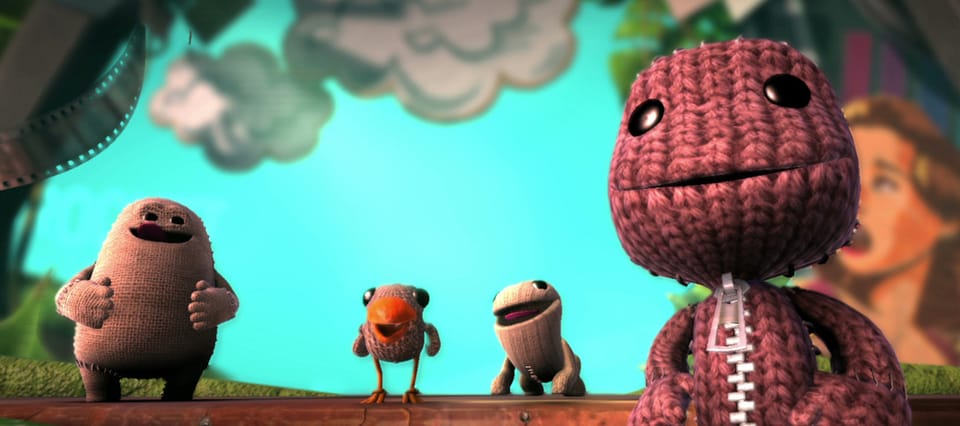LittleBigPlanet 3 is full of toys and joy

Nobody mourned the loss of Crash Bandicoot. Croc and Bubsy never penetrated the popular imagination. Jak and Daxter were retired without protest, joining Spyro the Dragon and Gex the Gecko in quiet obsolescence. And it is a dull child indeed who nursed affection for Sly Cooper, that larcenous bipedal racoon. Breakfast cereals have more intriguing mascots. Sony made do for more than a decade with this lot of colorless milquetoasts, these exemplars of mediocrity, before conceding that perhaps an analog of Mario would remain forever beyond their grasp. So in 2008 they tried the opposite approach. It worked. It’s an irony typical of the industry that Sony’s most memorable hero would be totally featureless and deliberately nondescript: Sackboy, a blank slate in chestnut sackcloth with black lozenge eyes—the ultimate anti-character.
The ultimate anti-character.
Six years later, with the arrival of LittleBigPlanet 3, the appeal of Sackboy persists undiminished, for the simple reason that he remains quite literally what you make of him: Magenta-hued with turquoise polka dots, say, or tricked out in starched cuffs and a coiffed Renaissance wig. And, of course, because this pliancy extends to so many other aspects of the LittleBigPlanet experience, you never feel cheated by Sackboy’s default blandness: That the game defers to your tastes and instincts instead of imposing its own is precisely the point. As Stephen Fry’s drolly omniscient narrator likes to so often remind you, the watchword of LittleBigPlanet is “imagination”—both the developers’ and your own. The malleability of the hero is emblematic of that spirit, the first of many canvases primed expressly for you. And for many thousands of others, naturally: Part of the ongoing fascination of the LittleBigPlanet series has been in watching its community of amateur architects labor toward a body of work that now seems virtually inexhaustible.

At the time of LittleBigPlanet 3’s launch, more than 9 million user-generated levels are available to enjoy. This is a creative reservoir to draw from for years—good news for those who aren’t feeling particularly imaginative, or those for whom playing a game inspires no real urge to actively contribute to it. LittleBigPlanet has always endeavored to be both a vehicle for the creativity of the player and a game with its own coherent artistic vision, which is to say that it’s been designed to be both played and played with; thus despite the wealth of customization options afforded to you in everything from costume paraphernalia to decorative stickers, you’re never pressured to do anything with them. In order to impress upon you that this is a game possessed of the creative spirit even if you aren’t inclined to tinker, LittleBigPlanet has adopted something of an aesthetic of the imagination—childlike, cluttered, vaguely whimsical. Things don’t look made; they look cobbled. The world has a sort of spare-parts quality: Every object looks as if it has been discarded from somewhere else, fashioned to its purpose haphazardly.
This is a creative reservoir to draw from for years.
LittleBigPlanet 3 retains this handcrafted aspect and, with next-generation hardware humming quietly away beneath the surface, expands and refines it. This world has undergone an appreciable enrichment: Environments are larger and denser, but also more thoughtfully and therefore elegantly arranged; even static backgrounds have a new sense of compositional movement, of visual rhythm. The structure of the game has been appropriately overhauled to suit this newly expanded scale. In lieu of the straightforward level-by-level progression found in previous installments, LittleBigPlanet 3 has been divided into a number of massive, multidirectional hub worlds, littered throughout which are access points to all manner of missions, side quests, and hidden collectables. (There are also golden baubles to be accumulated, used as currency to purchase novel costumes and other ephemera.)

These hub worlds are traversed, in the familiar Metroid fashion, by the acquisition of upgrades to your navigational repertoire, including a helmet-bound zipline and a nifty pair of rocket-powered boots; thus equipped, these items permit you to advance to formerly inaccessible regions, as well as open older worlds to rediscovery. These power-ups do much to invigorate a platforming system whose sense of locomotion had always felt a little sluggish. Where previous games found you ambling clumsily around obstacles, never with much precision, LittleBigPlanet 3 finds you deftly whooshing and zooming to and fro, a supple ragdoll gymnast. The controls, in keeping with this enlivening, have been considerably tightened, lending the sudden velocity of your movements a commensurate sense of command. Most electrifying of all these furnishings is a sort of demented portal gun, which fires rubbery orbs that bounce around the room; when these orbs make contact with small patches of neon blue slathered about, you instantly teleport into them. The game has devised puzzles around these teleportation schemes that are worthy of Valve.
A jolt of exhilaration—of imagination
These toys are your Sackboy’s animating force, and they render once-stolid actionsrefreshingly elastic and breezy. But the toys aren’t the extent of it. In addition to these robust adornments, LittleBigPlanet 3 boasts a further three additions to its core mechanics: A trio of redesigned sacks. They are the somewhat cloyingly named OddSock, a sort of yippy cloth dog; Toggle, a big potato with Ant-Man powers; and Swoop, a bird. Each has not only its own abilities, but its own style of play, from breakneck acrobatics to airborne getaways. The mutt can dash up walls and bound between them; the heavy can shrink to a tenth the size with the push of a button. Each has a host of levels catered to their particular talents, and—quite amusingly, given Sony’s decade-long quest for a likeable hero—each could be the star of their own game. Nevertheless, these new elements have been seamlessly integrated into the recognizable LittleBigPlanet foundation, and as a consequence never feel like the source of drastic change. What they offer instead is rejuvenation: a jolt of exhilaration—of imagination—from a series whose novelty had perhaps begun to wane.



